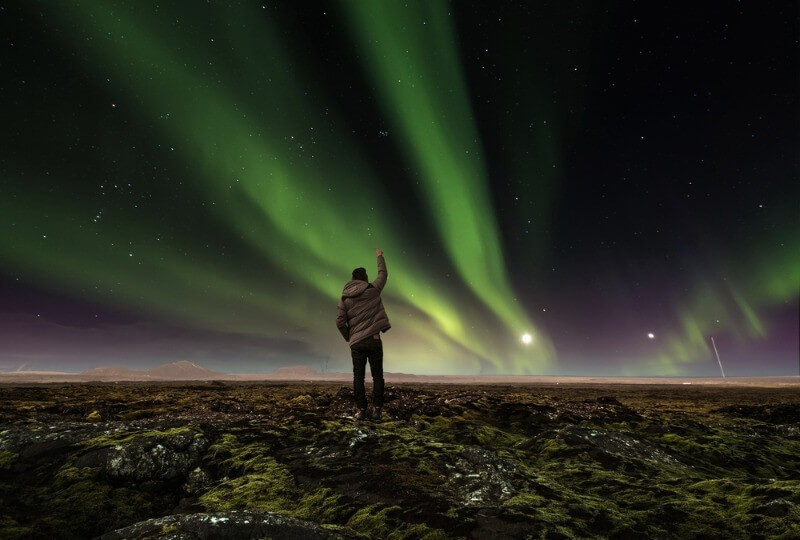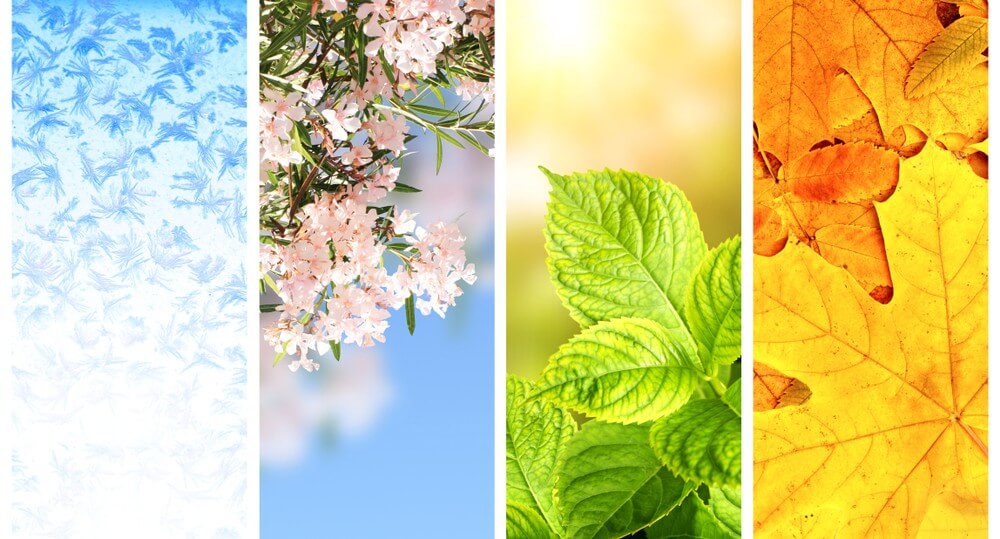Iceland in March is where winter and spring battle for control, and you get caught in the middle. One day, it feels like a frozen wonderland; the next, you are dodging slush puddles the size of small lakes.
The wind? Let's just say holding onto your hat becomes a full-time job. But fewer tourists, longer daylight hours, and the lingering Northern Lights make up for the unpredictability.
If you dress smart and roll with the surprises, March in Iceland offers some of the most stunning sights of the year. If you plan on driving with a rental cal in Iceland in March, just expect the weather to keep you on your toes.

What Is the Weather Like in Iceland in March?
You can summarize the weather in Iceland in March in just one word, and that would be UNPREDICTABLE. The best approach? Accept defeat and dress for everything.
What Is the Temperature in Iceland in March?
The temperature in Iceland in March is, on average, between -2°C and 3°C (28°F to 37°F), but the wind makes sure it feels much colder. The weather in Reykjavík in March might be slightly milder, but head north or into the highlands, and you will find winter still in full control.
March also likes to keep things wet, dumping around 82 mm of precipitation. Snow? Yes. Rain? Also yes. Both at the same time? Absolutely. For a more in-depth look at the various regions and their weather patterns, check out our guide on Icelandic weather information to get a better understating of what to expect in different areas.

Daylight in Iceland in March: How Many Hours of Sunlight Are There?
At least the daylight situation improves. Early in the month, you get about 10 hours of sun, with sunrise around 8:30 AM. By late March in Iceland, that stretches to nearly 13 hours, which means more time to explore.
Sunsets happen past 8:00 PM but don't worry, there is still enough darkness for Northern Lights spotting. Not that the weather always cooperates, but at least the odds are better.
Driving in Iceland During March: Safety & Road Conditions
Driving in Iceland in March is not like back home. The roads demand your full attention, and winter conditions make even short trips an experience. If you are expecting smooth highways and predictable terrain, think again.
Iceland also has a few other road rules that might come as a surprise to you, including toll roads. To avoid unexpected fees, check out this complete guide to Iceland's toll roads before hitting the road.

Road Conditions and Safety
Icy roads, snow-covered stretches, and strong winds make driving more challenging, especially outside the cities. Black ice is the biggest hazard.
It forms in shaded areas, on bridges, and along open roads, making it nearly impossible to see until your tires lose grip. The best way to handle it? Assume it is always there. Drive slow, avoid sudden braking, and steer gently.
Road closures are common, especially in mountain areas and rural routes. Some roads stay shut for weeks. Emergencies can also happen in the blink of an eye. So, it is essential to know whom to call if you need help. For everything from roadside assistance to medical emergencies, read this Iceland emergency number guide before you go.
Essential Driving Tips
When you travel to Iceland in March then driving does not have to be complicated, but it does require common sense and a little planning. Follow these tips to keep your trip safe and stress-free.

Check Road Conditions Daily
Road closures happen, and Iceland does not care about your itinerary. Use Umferdin.is and SafeTravel to stay updated on conditions. If a route is marked as impassable, believe it. Weather warnings are not suggestions.
Winter Tires are Mandatory
From November 1 to April 14, winter tires are not optional. If you rent with us, we include them at no extra cost. They are the only thing standing between you and an unplanned ice-skating session with your car. If you're unfamiliar with driving in snow, we highly recommend you read this guide about snow driving in Iceland.
Drive According to Conditions
There are speed limits in Iceland, but they do not account for black ice, snow, or slush. Drive at a pace that makes sense, leave extra space between cars, and avoid slamming on the brakes unless you want to test Iceland's roadside rescue services.

Pack an Emergency Kit
A first-aid kit, warm blankets, snacks, and a flashlight should be in every car. Getting stuck is rare, but if it happens, you will be glad you came prepared. Keep your headlights on at all times. Icelandic law requires it, and visibility can change in minutes.
Avoid Off-Roading
Iceland takes nature seriously. Driving off-road is illegal and comes with massive fines. Stick to marked roads unless you feel like donating to Iceland's environmental protection fund.
F-Roads Are Closed in March
F-roads are Iceland's rugged mountain tracks leading into the highlands, and they are completely off-limits in March. These roads only open in summer, once the snow melts and conditions are safe. Even if you have a 4x4, you will not be able to access them.

Familiarize Yourself with Icelandic Road Signs
There might be a few road signs in Iceland that might not be familiar to you. Before hitting the road, take a few minutes to learn what they mean. Some of the most important ones include:
- Malbik Endar – The paved road is ending, and gravel is ahead.
- Einbreið Brú – A single-lane bridge. Slow down and let oncoming traffic pass.
- Blindhæð – A blind hill where you cannot see oncoming cars. Approach carefully.
- Óveður – Severe weather warning. Time to rethink that road trip.
Where to Check the Weather Before Driving
To avoid nasty surprises, always check conditions before heading out using Vedur.is. This is Iceland's official website for weather forecasts, so you can trust the information provided.

Vehicle Selection for March Travels
A 4x4 is your best bet for driving in Iceland this time of year. It handles rough terrain better, gives you more control, and is required for certain routes. If you plan to explore beyond Reykjavík, do yourself a favor and rent a vehicle that is built for the job.
Need help more help picking the right one? We've made a complete guide to choosing the best rental car for Iceland.
What Vehicles Do We Recommend?
Picking the right 4x4 for Iceland is like picking the right jacket for winter. Sure, you could go with the cheapest option, but you will regret it when the conditions get tough. Here is why these models are solid choices.
Subaru XV 4x4 (Automatic) The Reliable Choice
Handles well on both paved and gravel roads, does not guzzle fuel, and lets you relax with an automatic transmission. If you want a capable 4x4 that does not feel bulky, this is a great pick.

Suzuki Jimny 4x4 (Manual) Small but Mighty
Looks cute, drives tough. The Jimny is built for rugged terrain, making it a fun choice if you are comfortable with a manual. Just do not expect much luggage space. If you overpack, your bags will be riding shotgun.
Toyota RAV4 4x4 (Automatic) Spacious and Comfortable
Ideal for long drives, with plenty of room for luggage and passengers. While it is a 4x4, it is better suited for paved and gravel roads rather than anything too rough. If comfort is a priority, this one is a winner.
Jeep Compass 4xe (Automatic) Eco-Friendly with Extra Grip
A hybrid that balances power and efficiency. Good fuel economy, extra traction, and a smooth ride. If you want something modern with solid stability, this is a strong option.

Dacia Duster 4x4 (Manual) Affordable and Tough
A no-nonsense workhorse that handles Iceland's roads without breaking the bank. It may not have luxury features, but it is reliable and gets the job done.
Top Attractions You Should Visit in Iceland in March
Iceland is the kind of place that was made for road trips. March still has a winter feel, but the major roads are open, and the landscapes? Unreal. You could spend weeks exploring, but if you are planning your Iceland March itinerary, here are a few places you do not want to miss.

The Golden Circle in March
If you only have time for one road trip, this is the one. It is short, easy, and loaded with some of the best things to do in Iceland in March. No long detours, just straight-up iconic sights. Thingvellir National Park is where history and nature come together. You can walk between two tectonic plates, which is about as close as it gets to straddling continents.
This is also where Iceland's first parliament was held back in the Viking days, which makes it even cooler. Then there is the Geysir area. Strokkur, the main geyser, puts on a show every few minutes, blasting boiling water high into the air.
Stand too close, and you might get an unexpected steam shower. Gullfoss Waterfall is next. It is loud, powerful, and drops into a canyon in a way that looks straight out of a movie. If it is cold enough, the mist freezes on the rocks, turning the whole thing into a frozen wonderland. The best part? You can do the whole Golden Circle in half a day no rush.
The South Coast Road Trip
Take the Ring Road south, and get ready for some of the most unreal scenery Iceland has to offer. Waterfalls? Check. Black sand beaches? Got those, too. Cliffs that look like something out of a fantasy movie? Of course. It is like Iceland threw all its best sights into one stretch of road just to flex.
First up is Seljalandsfoss, the waterfall that lets you walk behind it. Sounds magical, right? It is if you enjoy getting soaked. No matter how well you plan your route, how fast you sprint, or how much you 'stay to the side,' the mist will find you. Bring a rain jacket unless you enjoy the feeling of cold water slowly creeping into your socks.
A little further down, Skógafoss comes crashing into view. This one is impossible to miss. You will see it before you hear it, and you will hear it before you get close enough to feel the mist hitting your face. There is a staircase next to it that leads to an epic viewpoint. Climbing it sounds like a good idea until you are halfway up questioning your life choices. The view at the top? Totally worth it. Your legs will forgive you (eventually).

Keep driving east, and you will hit Reynisfjara, the famous black sand beach near Vík í Mýrdal. The sand is jet black, the basalt columns look like something designed by an architect who got a little too creative, and the waves? Absolutely terrifying. Sneaker waves here have a habit of dragging people into the Atlantic, and let's be honest, that is not how you want your Iceland trip to end. Take your photos, admire the beauty, and stay away from the water unless you want to star in an unfortunate headline.
The best part about this drive? It is ridiculously easy. Everything is right off the Ring Road, so there is no need for complicated routes or backtracking. Just keep driving and let Iceland do its thing.
Exploring the Snæfellsnes Peninsula
The Snæfellsnes Peninsula is for the people who want all the landscapes without the traffic jam at every scenic stop. This place has it all, including mountains, cliffs, glaciers, lava fields, and tiny fishing villages where time seems to move at half speed. And the best part? You will not be battling tour buses at every pull-off.
The one landmark everyone knows is Kirkjufell Mountain. If you have seen a postcard of Iceland, you have seen this mountain. It pops up in every travel guide, and at this point, it has probably been photographed more than half of Hollywood. If you blinked, you might have caught it in Game of Thrones, too. In March, it is usually dusted with snow, which somehow makes it even more surreal.

Further down the coast, things start getting rugged. The cliffs near Arnarstapi are wild, with the kind of walking trails that make you stop and stare every five minutes. Waves slam into the rocks below, and the wind? Let's just say you will not need a hairdryer. Then there is Djúpalónssandur Beach, where the sand is made of tiny black pebbles, and rusted pieces of an old shipwreck are still scattered across the shore. It is eerie, beautiful, and makes you wonder how many unlucky sailors ended up here.
Snæfellsnes is only a few hours from Reykjavik, but it feels like it is in its own world. Do not expect cell service in every corner, so maybe let someone know where you are heading before you get too lost in the scenery.
Explore the City: The Best Things to Do in Reykjavík in March
March in Reykjavík is a magical time—winter still lingers, but longer daylight hours hint at spring’s arrival. Whether you’re seeking relaxation, culture, or a cozy spot to warm up, here are the best things to do:

Hot Springs & Spas
There’s no better way to embrace Iceland’s geothermal wonders than by soaking in a steamy hot spring. The Blue Lagoon remains a classic, but for a more local experience, head to Sky Lagoon, where you can enjoy a breathtaking oceanfront infinity pool. If you’re staying in the city, Laugardalslaug, Reykjavík’s largest public pool, is a fantastic budget-friendly option with hot tubs and a steam bath.
Museums & Cultural Events in March
March offers a great mix of history and arts in Reykjavík’s museums. The National Museum of Iceland dives deep into the country’s Viking heritage, while the Perlan Museum’s Ice Cave gives you a taste of Iceland’s frozen landscapes. If you're into contemporary art, don’t miss the Reykjavík Art Museum. Plus, March often features cultural festivals—check out events at Harpa Concert Hall for live music and performances.

Best Local Bars & Cafés to Warm Up
After a chilly day exploring, warm up in one of Reykjavík’s charming cafés. Try Kaffibrennslan for a cozy atmosphere or Mokka Kaffi, one of the city’s oldest coffee houses. For a taste of local nightlife, grab a drink at Kaldi Bar or Dillon Whiskey Bar—perfect spots to unwind with Icelandic craft beer or whiskey.
March in Reykjavík is all about blending adventure with relaxation, so take your pick and make the most of this vibrant season!
Seasonal Activities Visit Iceland in March
While traveling to Iceland in March, do not just stick to the popular tourist spots. There are plenty of unique and engaging activities that you can only experience during this month.
Snowmobiling on Icelandic Glaciers
Did anyone say 'snowmobile?' Yes, please! Iceland in March is the perfect time to do it. The snow is fresh, the landscapes are unreal, and the rush of speeding over ice is hard to beat. Tours run on Langjökull, Iceland's second-largest glacier, where you can carve through open snowfields with nothing but mountains in the distance.

For the easiest experience, book a snowmobile tour from Reykjavík. Many tours include pickup, so all you have to do is show up, gear up, and let the guides handle the rest. For more info, read our full guide on snowmobiling in Iceland.
Northern Lights Tour
Some of you may be wondering if you can still see the Northern Lights in Iceland in March. Well, good news! The Northern Lights in Iceland are still in full swing. Peak season runs from September to mid-April, so your chances of seeing them are high. You will need clear skies and a spot away from city lights. Thingvellir National Park, Grotta Lighthouse, and the Snæfellsnes Peninsula are all great choices.
Want to make it extra special? Take a Northern Lights Cruise. Watching the auroras dance over the open ocean? That is next-level romance. March is still peak season for the Northern Lights, so bring a warm coat, a little patience, and someone worth cuddling.

Ice Cave Tours & Glacier Walks
If you're looking for epic things to do in March in Iceland, then step inside a glacier. Ice caves are at their best this time of year, glowing in shades of blue that look almost unreal. Guided tours take you deep into frozen tunnels and towering ice formations, making for a surreal adventure.
For serious thrills, Langjökull Glacier tours let you snowmobile or even drive inside the glacier itself. If walking through a frozen wonderland sounds more your speed, the Skaftafell Ice Cave and Glacier Walk is a must.
Celebrate Beer Day (Bjórdagurinn March 1st)
March 1 is a sacred day in Iceland. Not for Viking traditions or epic sagas but for something far more important. Beer. For 74 long, dry years, Iceland banned it. Then, in 1989, sanity prevailed, and the country finally lifted the ban.
Naturally, people celebrate like they have decades of lost time to make up for. If you are looking for things to do in Reykjavík in March, bar-hopping is practically required. Hit spots like Ölgerðin, Skúli Craft Bar, or MicroBar and raise a glass to Iceland's greatest comeback story.

How to prepare for Your Iceland March Road Trip
Before you hit the road, do yourself a favor and don't skip this part:
Packing Checklist for Iceland in March
Packing smart for this time of the year is not optional. Bring gear that keeps you warm, dry, and ready for anything.
- Layered clothing – A thermal base, an insulating mid-layer, and a waterproof jacket will keep you comfortable in shifting conditions.
- Waterproof boots – Sneakers will not survive the wet, slushy terrain. Get something sturdy and warm.
- Gloves and a hat – Cold hands and ears make everything less fun.
- Wool socks – Regular socks will not cut it. Wool keeps your feet warm even if they get wet.
- Sunglasses – Snow glare is no joke, and neither is squinting your way through an entire trip.
- Backpack – A small, waterproof daypack keeps your essentials dry while exploring
Maps, GPS & Navigation Tips
Google Maps is great until your signal disappears in the middle of nowhere. Do not assume you will have perfect coverage, especially on remote roads. Download offline maps or rent a GPS device from us so you do not end up making an accidental detour into the highlands. Icelandic road signs can be... minimal at best, so know where you are going before you start driving.

Booking Accommodation in Advance
Thinking of winging it and booking as you go? Bad idea. Lodging fills up fast, even in March, and some areas have very few options. Book ahead unless you enjoy the thrill of sleeping in your rental car. Remote regions have even fewer choices, so plan your stops in advance if you want a warm bed instead of a front seat. For your convenience we did an entire article on some of the best AirBnbs in Iceland, so it definitely worth reading it.
Money-Saving Tips for Traveling to Iceland in March
Iceland is not cheap, but that does not mean you have to spend a fortune. A few smart choices can keep costs down without sacrificing the experience. Here are some useful money-saving hacks to travel to Iceland on a budget:
- Stock up on groceries – Eating out adds up fast. Grab snacks, breakfast items, and easy meals from these budget-friendly Icelandic supermarkets like Bónus or Krónan.
- Refill your water bottle – Icelandic tap water is some of the purest in the world. Skip the bottled stuff and bring a reusable bottle.
- Book accommodations early – Last-minute stays can be pricey. Lock in lower rates by reserving in advance.
- Use fuel discount cards – Some gas stations offer discount cards for travelers. Pick one up and save on every refill.
- Skip paid attractions – Many of Iceland's best sights are free. Waterfalls, hot springs, and scenic drives cost nothing.
- Avoid airport currency exchange – The exchange rates are terrible. Use a credit card with no foreign transaction fees instead.

Gas Prices in Iceland
Fuel prices in Iceland are not cheap, so expect to spend a chunk of your budget keeping your car moving. As of now, gas prices sit around $2.30 USD per liter for petrol and $2.34 USD per liter for diesel. If you are used to cheap fuel back home, this might sting a little.
- Not all gas stations charge the same – Prices vary between brands, so shop around. N1, Orkan, and Olís often have discount cards that can save you money.
- Self-service is standard – Many stations, especially in remote areas, have no staff. You will need a credit or debit card with a PIN to use the pumps.
- Plan your stops – Some areas have limited fuel stations, so do not wait until you are running on fumes. Fill up when you can, especially before heading into the countryside.
Why Visiting Iceland in March is Totally Worth It
Iceland in March is the perfect mix of winter beauty and growing daylight. Fewer crowds, cheaper stays, and landscapes still covered in snow make it a dream for road trippers. Renting a car in Iceland gives you total freedom. No waiting on buses, no rigid schedules, just the open road and endless sights. Public transport is limited, slow, and nowhere near as fun.
Chase, the Northern Lights, walk through ice caves and drive the Ring Road at your own pace. Every turn brings a new adventure. Pack smart, plan ahead, and embrace the thrill of exploring Iceland on your terms.

FAQs About Iceland in March
Is March a good time to visit Iceland?
Yes, March is a great time to visit. You get fewer crowds, winter scenery, and longer daylight hours. It is perfect for Northern Lights, ice caves, and road trips without peak-season prices.
How cold is it in Iceland in March?
Expect temperatures between -2°C to 3°C (28°F to 37°F). It feels colder with wind, but good layers make all the difference. Snow, rain, and sunshine can happen within the same day.
What to do in Iceland in March?
Go Northern Lights hunting, explore ice caves, soak in hot springs, visit waterfalls, and drive the Golden Circle or South Coast. March offers winter landscapes with increasing daylight for adventure-filled days.

Can you see the Northern Lights in Iceland in March?
Yes, March is peak aurora season. Head outside Reykjavík for the best views, or take a Northern Lights cruise for an unforgettable experience under the open Arctic sky.
What are Iceland's driver's license requirements?
Driver license requirements in Iceland state that visitors must have a valid license from their home country. If it is not in Latin script, an international driving permit (IDP) is required. Most rentals require drivers to be 21+.


 By
By


